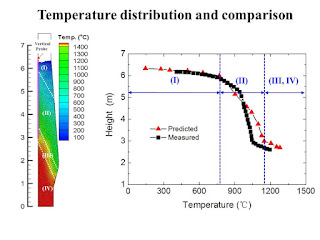DEM-based virtual experimental blast furnace: A quasi-steady
state model
Q. F. Hou,1* D. Y. E,1 S. B. Kuang,1
Z. Y. Li,1 and A. B. Yu1,2*
Corresponding authors, Email: qinfu.hou@monash.edu (QFH) and
aibing.yu@monash.edu (ABY).
1Laboratory for Simulation and Modelling of
Particulate Systems, Department of Chemical Engineering, Monash University,
Clayton, VIC 3800, Australia
2Centre for Simulation and Modelling of
Particulate Systems, Southeast University - Monash University Joint Research
Institute, Suzhou 215123, PR China
http://www.sciencedirect.com/science/article/pii/S0032591016308853
Abstract
Intensive
heat and mass transfer between continuum fluids and discrete particulate
materials is quite common in many chemical processes. To understand and improve
the operation of these processes, discrete particle models are very helpful
when they are combined with the flow, heat transfer and chemical reaction
models. Here, a quasi-steady state model for investigating thermo-chemical
behaviors is established and tested for an experimental blast furnace (BF).
First, the new treatments and assumptions are discussed in detail. Then, the
model is tested against available experimental data under comparable conditions
in terms of in-furnace flow state, temperature distribution, and the
characteristics of the cohesive zone. Finally, a discussion of further
development is presented. Such a model can be used to study the effects of
burden distribution, inlet gas composition and material properties on the
operation and energy efficiency of a BF. Such particle scale modeling can be
extended to other chemical processes such as fluidized beds and rotary kilns
not only for better fundamental understanding but also for better process
design and control.
Keywords: Blast furnace,
Heat and mass transfer, Chemical reaction, Discrete element method,
Computational fluid dynamics
No comments:
Post a Comment